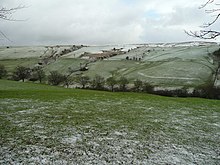Mynydd Epynt: Difference between revisions
Created page with "thumb|220px|View east from Blaen Bwch Farm '''Mynydd Epynt''' is an upland area of Brecknockshire. It is bounded to the..." |
No edit summary |
||
| (One intermediate revision by the same user not shown) | |||
| Line 1: | Line 1: | ||
{{county|Brecon}} | |||
[[File:View east from Blaen Bwch Farm 674351.jpg|thumb|220px|View east from Blaen Bwch Farm]] | [[File:View east from Blaen Bwch Farm 674351.jpg|thumb|220px|View east from Blaen Bwch Farm]] | ||
'''Mynydd Epynt''' is an upland area of [[Brecknockshire]]. It is bounded to the south by the upper section of the valley of the [[River Usk]], to the north by that of the [[ | '''Mynydd Epynt''' is an upland area of [[Brecknockshire]]. It is bounded to the south by the upper section of the valley of the [[River Usk]], to the north by that of the [[River Irfon]] and to the east by the valley of the [[River Wye]]. Its western boundary is less distinct but lies eastward of the A483 [[Llandovery]] to [[Llanwrtyd Wells]] road. Its character is that of an extensive though dissected moorland plateau lying between 1,300 and 1,500ft above sea level and whose highest point of 1,568ft is reached at an unnamed rise at OS grid ref SN 961464. | ||
The south-western part of Mynydd Epynt is known as '''Mynydd Bwlch-y-groes'''. The area is drained by several southward-flowing rivers which empty into the [[River Usk]]. These include (from west to east) the Cilieni, [[Nant Bran]], [[Afon Ysgir]] (with its two headwaters the Ysgir Fechan and Ysgir Fawr) and [[River Honddu (Usk)|River Honddu]]. The Duhonw drains north-eastward into the [[River Wye]].<ref>Ordnance Survey Explorer maps 187 & 188 'Llandovery' & 'Builth Wells'</ref> | The south-western part of Mynydd Epynt is known as '''Mynydd Bwlch-y-groes'''. The area is drained by several southward-flowing rivers which empty into the [[River Usk]]. These include (from west to east) the Cilieni, [[Nant Bran]], [[Afon Ysgir]] (with its two headwaters the Ysgir Fechan and Ysgir Fawr) and [[River Honddu (Usk)|River Honddu]]. The Duhonw drains north-eastward into the [[River Wye]].<ref>Ordnance Survey Explorer maps 187 & 188 'Llandovery' & 'Builth Wells'</ref> | ||
| Line 23: | Line 24: | ||
==References== | ==References== | ||
{{Reflist}} | {{Reflist}} | ||
{{ | |||
==Outside links== | |||
*Location map: {{wmap|52.067|-3.517|zoom=14}} | |||
[[Category:Mountains and hills of Brecknockshire]] | [[Category:Mountains and hills of Brecknockshire]] | ||
Latest revision as of 09:03, 23 October 2018

Mynydd Epynt is an upland area of Brecknockshire. It is bounded to the south by the upper section of the valley of the River Usk, to the north by that of the River Irfon and to the east by the valley of the River Wye. Its western boundary is less distinct but lies eastward of the A483 Llandovery to Llanwrtyd Wells road. Its character is that of an extensive though dissected moorland plateau lying between 1,300 and 1,500ft above sea level and whose highest point of 1,568ft is reached at an unnamed rise at OS grid ref SN 961464.
The south-western part of Mynydd Epynt is known as Mynydd Bwlch-y-groes. The area is drained by several southward-flowing rivers which empty into the River Usk. These include (from west to east) the Cilieni, Nant Bran, Afon Ysgir (with its two headwaters the Ysgir Fechan and Ysgir Fawr) and River Honddu. The Duhonw drains north-eastward into the River Wye.[1]
The Welsh-language name means mountain (crossed by a) horse-path. It is often misspelt as Mynydd Eppynt. In earlier times it was known simply as Epynt and is commonly referred to today as 'the Epynt'.[2]
Geology
Mynydd Epynt is largely formed from the Raglan Mudstone Formation and the St Maughans Formation of the Old Red Sandstone laid down during the latest part of the Silurian period and the succeeding Devonian period though there is little in the way of rock exposures at the surface. The northern and western escarpment of Mynydd Epynt is formed from a suite of rocks assigned to the Ludlow stage of the late Silurian and which include the Temeside Mudstone, the Tilestones, the Cae'r Mynach, Fibua, Aberedw, Cwm Craig Ddu and Irfon Formations. These consist variously of sandstones, mudstones and siltstones.
There is a broken spread of glacial till across the area resulting from its inundation by ice from the mid Wales ice sheet to the north during the ice ages and hill peat has accumulated in some areas in post-glacial times.[3]
Military presence
The Ministry of Defence acquired several thousand acres of Mynydd Epynt in 1939. This now forms the core of the Sennybridge Training Area (SENTA). Unsurprisingly this move was a controversial one, not least for those people who were required to vacate their land.
Access
The core area of Mynydd Epynt is used by the MOD as a military training area and artillery range. There is therefore little access across this land. Outlying areas are mapped as Open Country or open-access land and therefore available to hill-walkers to wander at will. The MOD have however established a trail, the Epynt Way, around the perimeter of the range which caters for walkers, horse riders and mountain-bikers. A visitor centre has been established by Defence Estates at Disgwylfa, north of Upper Chapel beside the B4519 road from Brecon to Garth.[4] Originally established as an interpretive facility in the 1990s, this one-time farmhouse has been refurbished and re-opened in 2009 as 'Canolfan Epynt' (the 'Epynt Centre').
Outside links
References
- ↑ Ordnance Survey Explorer maps 187 & 188 'Llandovery' & 'Builth Wells'
- ↑ Owen, H.W. & Morgan, R. 2007 'Dictionary of the Place-names of Wales' Gomer Press, Cardiganshire
- ↑ British Geological Survey 1:50,000 map sheet 196 'Builth Wells' & accompanying sheet explanation
- ↑ http://www.defence-estates.mod.uk/epyntway/
Outside links
- Location map: 52°4’1"N, 3°31’1"W